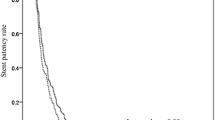Abstract
Background and Aims
Self-expandable metallic stent insertion has been a mainstream treatment for relieving the obstructive symptoms of malignant gastric outlet obstruction (MGOO), a late-stage complication of gastrointestinal malignancies. This study aims to investigate the predictive value of stent expansion rates in clinical outcomes in patients with MGOO.
Methods
Eighty-seven patients with inoperable MGOO receiving metallic stents were reviewed retrospectively from April 2010 to December 2014. Clinical outcomes, predictors of stent patency, and survival were analyzed.
Results
The technical and clinical success rates were 100 and 94.3%, respectively. The median stent patency time was 114 days (range 13–570 days). The median survival time was 133 days (range 13–1145 days). Stent dysfunctions occurred in 28 patients (32.2%), with restenosis accounting for the majority (82%). The stent expansion rate ≥75% at Day 1 predicted the stent patency [hazard ratio (HR) 0.12, P = 0.04]. However, it did not correlate with survival. Non-gastric cancer origins (HR 2.41, P = 0.002) and peritoneal carcinomatosis (HR 2.54, P = 0.001) correlated with poor survival. However, post-stent chemotherapy (HR 0.55, P = 0.03) was related to better outcome. The comparison of clinical outcomes of first and second stent insertions showed no significant difference in the stent expansion rate either at Day 0 and Day 1 (P = 0.97 and P = 0.57).
Conclusions
Self-expandable metallic stent insertion is a safe and effective treatment for relieving the obstructive symptoms. The stent expansion rate ≥75% at Day 1 is a novel stent-related predictor of stent patency.





Similar content being viewed by others
Abbreviations
- SEMS:
-
Self-expandable metallic stent
- MGOO:
-
Malignant gastric outlet obstruction
- GOOSS:
-
Gastric outlet obstruction scoring system
- ECOG:
-
Eastern Cooperative Oncology Group
- UGI:
-
Upper gastrointestinal
- CT:
-
Chemotherapy
- RT:
-
Radiotherapy
- SD:
-
Standard deviation
- HR:
-
Hazard ratio
References
Del Piano M, Ballare M, Montino F, et al. Endoscopy or surgery for malignant GI outlet obstruction? Gastrointest Endosc. 2005;61:421–426.
Espinel J, Sanz O, Vivas S, et al. Malignant gastrointestinal obstruction: endoscopic stenting versus surgical palliation. Surg Endosc. 2006;20:1083–1087.
Roy A, Kim M, Christein J, Varadarajulu S. Stenting versus gastrojejunostomy for management of malignant gastric outlet obstruction: comparison of clinical outcomes and costs. Surg Endosc. 2012;26:3114–3119.
Hosono S, Ohtani H, Arimoto Y, Kanamiya Y. Endoscopic stenting versus surgical gastroenterostomy for palliation of malignant gastroduodenal obstruction: a meta-analysis. J Gastroenterol. 2007;42:283–290.
Fiori E, Lamazza A, Volpino P, et al. Palliative management of malignant antro-pyloric strictures. Gastroenterostomy vs. endoscopic stenting. A randomized prospective trial. Anticancer Res. 2004;24:269–271.
Jeurnink SM, Steyerberg EW, van Hooft JE, et al. Surgical gastrojejunostomy or endoscopic stent placement for the palliation of malignant gastric outlet obstruction (SUSTENT study): a multicenter randomized trial. Gastrointest Endosc. 2010;71:490–499.
Mehta S, Hindmarsh A, Cheong E, et al. Prospective randomized trial of laparoscopic gastrojejunostomy versus duodenal stenting for malignant gastric outflow obstruction. Surg Endosc. 2006;20:239–242.
Jeon HH, Park CH, Park JC, et al. Carcinomatosis matters: clinical outcomes and prognostic factors for clinical success of stent placement in malignant gastric outlet obstruction. Surg Endosc. 2014;28:988–995.
Sasaki T, Isayama H, Nakai Y, et al. Predictive factors of solid food intake in patients with malignant gastric outlet obstruction receiving self-expandable metallic stents for palliation. Dig Endosc. 2012;24:226–230.
Sato T, Hara K, Mizuno N, et al. Gastroduodenal stenting with Niti-S stent: long-term benefits and additional stent intervention. Dig Endosc. 2015;27:121–129.
Ye BW, Lee KC, Hsieh YC, et al. Self-expandable metallic stent placement in malignant gastric outlet obstruction: a comparison between 2 brands of stents. Medicine. 2015;94:e1208.
Hori Y, Naitoh I, Ban T et al. Stent underexpansion on the procedure day is a predictive factor for poor oral intake after metallic stenting for gastric outlet obstruction. J Gastroenterol Hepatol. 2015;30:1246–1251.
Piesman M, Kozarek RA, Brandabur JJ, et al. Improved oral intake after palliative duodenal stenting for malignant obstruction: a prospective multicenter clinical trial. Am J Gastroenterol. 2009;104:2404–2411.
Kim SH, Chun HJ, Yoo IK, et al. Predictors of the patency of self-expandable metallic stents in malignant gastroduodenal obstruction. World J Gastroenterol WJG. 2015;21:9134–9141.
Canena JM, Lagos AC, Marques IN, et al. Oral intake throughout the patients’ lives after palliative metallic stent placement for malignant gastroduodenal obstruction: a retrospective multicentre study. Eur J Gastroenterol Hepatol. 2012;24:747–755.
Kim CG, Choi IJ, Lee JY, et al. Outcomes of second self-expandable metallic stent insertion for malignant gastric outlet obstruction. Surg Endosc. 2014;28:281–288.
Sasaki T, Isayama H, Nakai Y, et al. Clinical outcomes of secondary gastroduodenal self-expandable metallic stent placement by stent-in-stent technique for malignant gastric outlet obstruction. Dig Endosc. 2015;27:37–43.
Acknowledgments
We thank Mr. Liao Dong-Ming for his excellent technical assistance.
Author information
Authors and Affiliations
Corresponding author
Ethics declarations
Conflict of interest
The authors declare that they have no conflict of interest.
Ethical approval
This study was approved by Institutional Review Board of Taipei Veterans General Hospital. All procedures performed in studies involving human participants were in accordance with the ethical standards of the institutional and/or national research committee and with the 1964 Helsinki declaration and its later amendments or comparable ethical standards.
Informed consent
Informed consent was obtained from all individual participants included in the study.
Rights and permissions
About this article
Cite this article
Ye, BW., Chou, CK., Hsieh, YC. et al. Metallic Stent Expansion Rate at Day One Predicts Stent Patency in Patients with Gastric Outlet Obstruction. Dig Dis Sci 62, 1286–1294 (2017). https://doi.org/10.1007/s10620-017-4534-x
Received:
Accepted:
Published:
Issue Date:
DOI: https://doi.org/10.1007/s10620-017-4534-x




